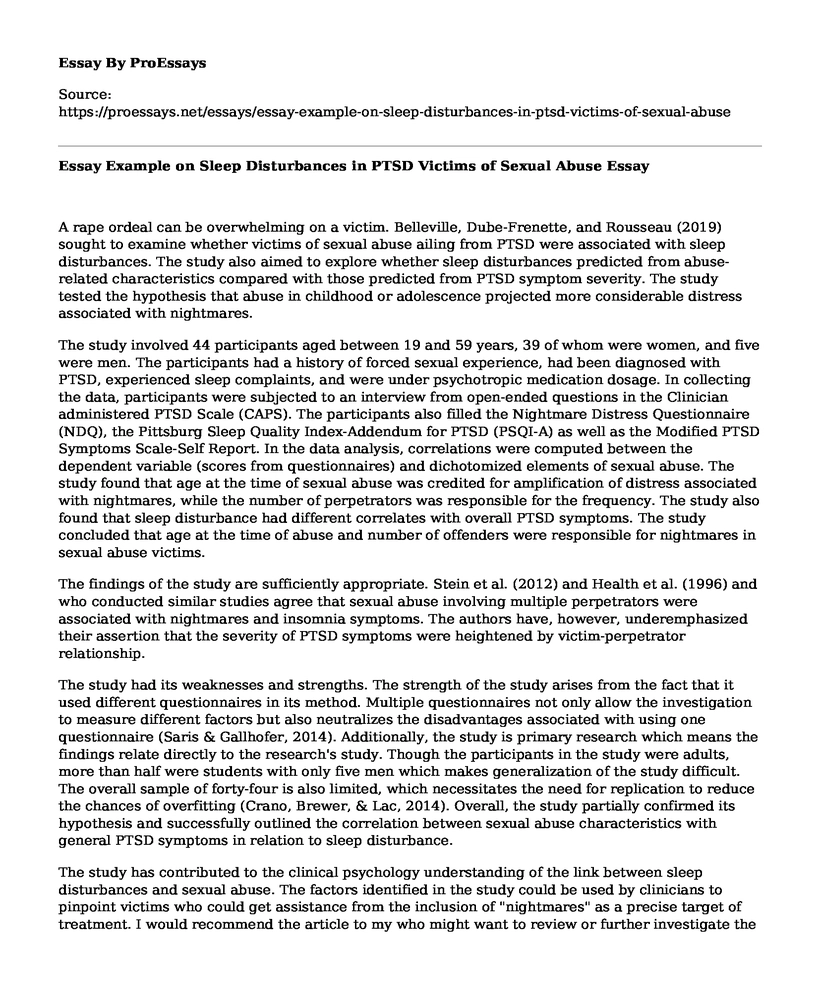A rape ordeal can be overwhelming on a victim. Belleville, Dube-Frenette, and Rousseau (2019) sought to examine whether victims of sexual abuse ailing from PTSD were associated with sleep disturbances. The study also aimed to explore whether sleep disturbances predicted from abuse-related characteristics compared with those predicted from PTSD symptom severity. The study tested the hypothesis that abuse in childhood or adolescence projected more considerable distress associated with nightmares.
The study involved 44 participants aged between 19 and 59 years, 39 of whom were women, and five were men. The participants had a history of forced sexual experience, had been diagnosed with PTSD, experienced sleep complaints, and were under psychotropic medication dosage. In collecting the data, participants were subjected to an interview from open-ended questions in the Clinician administered PTSD Scale (CAPS). The participants also filled the Nightmare Distress Questionnaire (NDQ), the Pittsburg Sleep Quality Index-Addendum for PTSD (PSQI-A) as well as the Modified PTSD Symptoms Scale-Self Report. In the data analysis, correlations were computed between the dependent variable (scores from questionnaires) and dichotomized elements of sexual abuse. The study found that age at the time of sexual abuse was credited for amplification of distress associated with nightmares, while the number of perpetrators was responsible for the frequency. The study also found that sleep disturbance had different correlates with overall PTSD symptoms. The study concluded that age at the time of abuse and number of offenders were responsible for nightmares in sexual abuse victims.
The findings of the study are sufficiently appropriate. Stein et al. (2012) and Health et al. (1996) and who conducted similar studies agree that sexual abuse involving multiple perpetrators were associated with nightmares and insomnia symptoms. The authors have, however, underemphasized their assertion that the severity of PTSD symptoms were heightened by victim-perpetrator relationship.
The study had its weaknesses and strengths. The strength of the study arises from the fact that it used different questionnaires in its method. Multiple questionnaires not only allow the investigation to measure different factors but also neutralizes the disadvantages associated with using one questionnaire (Saris & Gallhofer, 2014). Additionally, the study is primary research which means the findings relate directly to the research's study. Though the participants in the study were adults, more than half were students with only five men which makes generalization of the study difficult. The overall sample of forty-four is also limited, which necessitates the need for replication to reduce the chances of overfitting (Crano, Brewer, & Lac, 2014). Overall, the study partially confirmed its hypothesis and successfully outlined the correlation between sexual abuse characteristics with general PTSD symptoms in relation to sleep disturbance.
The study has contributed to the clinical psychology understanding of the link between sleep disturbances and sexual abuse. The factors identified in the study could be used by clinicians to pinpoint victims who could get assistance from the inclusion of "nightmares" as a precise target of treatment. I would recommend the article to my who might want to review or further investigate the correlation between sexual abuse, sleep disturbances, and general PTSD symptoms. The endorsement is based on the fact that the research is peer-reviewed, used the proper method in data collection and analysis, and is current.
Conclusion
Overall this article is very straightforward from the abstract to the conclusion. The article achieved its goal of examining whether victims of sexual abuse suffering from PTSD were associated with sleep disturbances. Scientists who might want to investigate further on the topic should aim at eradicating the weaknesses outlined in this review.
References
Belleville, G., Dube-Frenette, M., & Rousseau, A. (2019). Sleep disturbances and nightmares in victims of sexual abuse with post-traumatic stress disorder: an analysis of abuse-related characteristics. European Journal of Psychotraumatology, 10(1), 1581019. doi:10.1080/20008198.2019.1581019
Crano, W. D., Brewer, M. B., & Lac, A. (2014). Principles and Methods of Social Research. Routledge.
Heath V., Bean R., & Feinauer L. (1996). Severity of childhood sexual abuse: Symptom differences between men and women. American Journal of Family Therapy, 24(4), 305-314. (n.d.).
Saris, W. E., & Gallhofer, I. N. (2014). Design, Evaluation, and Analysis of Questionnaires for Survey Research. Hoboken, NJ: John Wiley & Sons.
Steine I. M., Krystal J. H., Nordhus I. H., Bjorvatn B., Harvey A. G., Eid J., ... Pallesen S. (2012). Insomnia, nightmare frequency, and nightmare distress in victims of sexual abuse: The role of perceived social support and abuse characteristics. Journal of Interpersonal Violence, 27(9), 1827-1843. (n.d.).
Cite this page
Essay Example on Sleep Disturbances in PTSD Victims of Sexual Abuse. (2023, Feb 09). Retrieved from https://proessays.net/essays/essay-example-on-sleep-disturbances-in-ptsd-victims-of-sexual-abuse
If you are the original author of this essay and no longer wish to have it published on the ProEssays website, please click below to request its removal:
- Aging Parents Essay Example
- Poverty in America Is Mainstream Article Review
- Essay Example on Nursing Student Characteristics: Skills for Future Success
- Mental Health: Comp. Study of Players vs Non-Players - Essay Sample
- Essay Example on Homelessness: Ignored Crisis Amidst COVID-19 Pandemic
- Wuthering Heights: A Timeless Tale of Love and Heartbreak - Essay Sample
- Essay Example on Developmental Psychology: Social Norms and the Human Life Course







